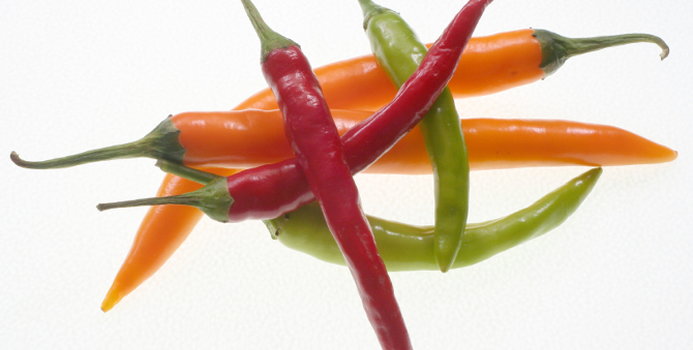Peppers offer many positive attributes when added to your diet. There are a wide variety of different types of peppers, from sweet to hot, and are used in everything from salads and cooking to alternative remedies. However, it is the hot peppers that have the most interesting benefits.
Capsaicin
Chili, jalapeno, habenero and cayenne peppers all contain a chemical component called capsaicin. This is the compound that causes the burning sensation when coming in contact with mucous membranes. It has also been attributed to:
- killing cancer cells
- reducing inflammation
- producing fat oxidation which can aid in weight loss
- helping with gastric relief
- preventing sinus infections
- psoriasis relief
The Wellness Encyclopedia of Food and Nutrition by Sheldon Margen, MD states that although most people think the capsaicin is found in the seeds it is the fleshy part surrounding the seeds that carries most capsaicin.
Vitamin C
Many hot peppers contain a high amount of vitamin C, and in some cases, as much as eighty to one hundred percent the recommended dailly allowance. One single chili pepper comes in at about fifty milligrams and one cup of jalapenos contains about forty milligrams. Vitamin C is essential in tissue repair, immune system enhancement, circulation, brain and mood function.
Vitamin B's
Vitamin B6 and Vitamin B2, or riboflavin, are found in most hot peppers. B6 helps with blood production, nervous system health and hormone function. B6 cannot be produced by the body. B2 also known as riboflavin has been attributed to helping reduce migraine headaches, assisting in enzyme and energy function, and is a strong antioxidant.
Vitamin A
Most abundant in hot peppers is vitamin A. The recommended daily allowance of vitamin A is between three thousand and five thousand international units or IU depending on age and gender. One single chili pepper contains approximately eight thousand IU's. Vitamin A helps red blood cell formation, immune system function, vision health and growth and development.
Vitamin E
Traces of vitamin E are in hot peppers, which directly effects skin as well as protection from outside pollutants such as cigarette smoke or car exhaust.
Asthma
Cayenne peppers have been used for years to help blood circulation throughout the body, especially to the lungs. By generating more blood flow to the lungs, this helps dilate the lung sacs that may be sluggish due to asthma. Hot peppers also stimulate mucous membranes in the nose, mouth and throat, helping dislodge stubborn built up phlegm caused by astma attacks.
Cool Off
Because hot peppers are often associated with making people sweat when they eat them, in turn it is no coincidence that most hot peppers grow in hot weather climates. Indigenous people to these areas use the peppers to actually cool off. When people perspire, the body immediately cools itself off.
Potassium
Small amounts of potassium are found in hot peppers, which is an essential mineral in enhancing muscle health.
Burn More Fat
Ingesting hot peppers ramps up the metabolism which in turn switches the body into fat burning mode.
Take Precautions
Although hot peppers have many health benefits, they are still hot. Be sure and take your time when eating hot peppers and have plenty of milk on hand, as the protein casein in milk is an excellent anti-burn remedy. Also, check with your doctor if you are on any medications and always wash your hands thoroughly when handling hot peppers because once you wipe your eye with a hot pepper laced hand, it can be very uncomfortable.



